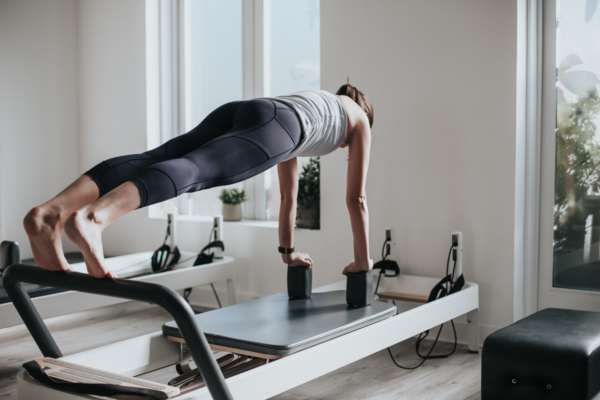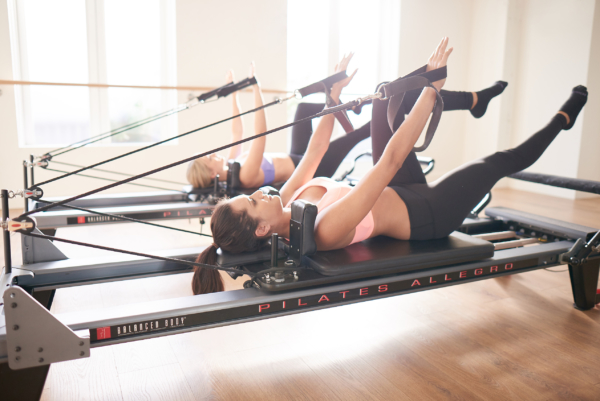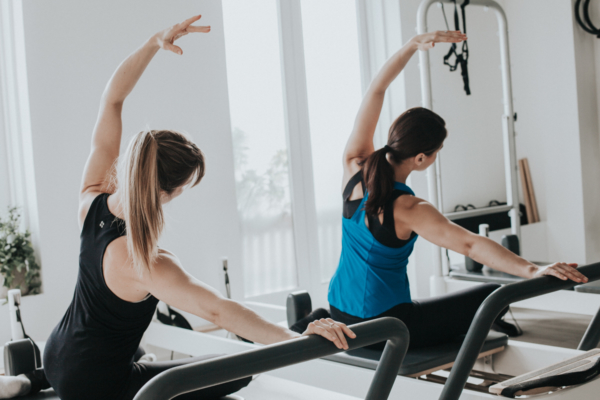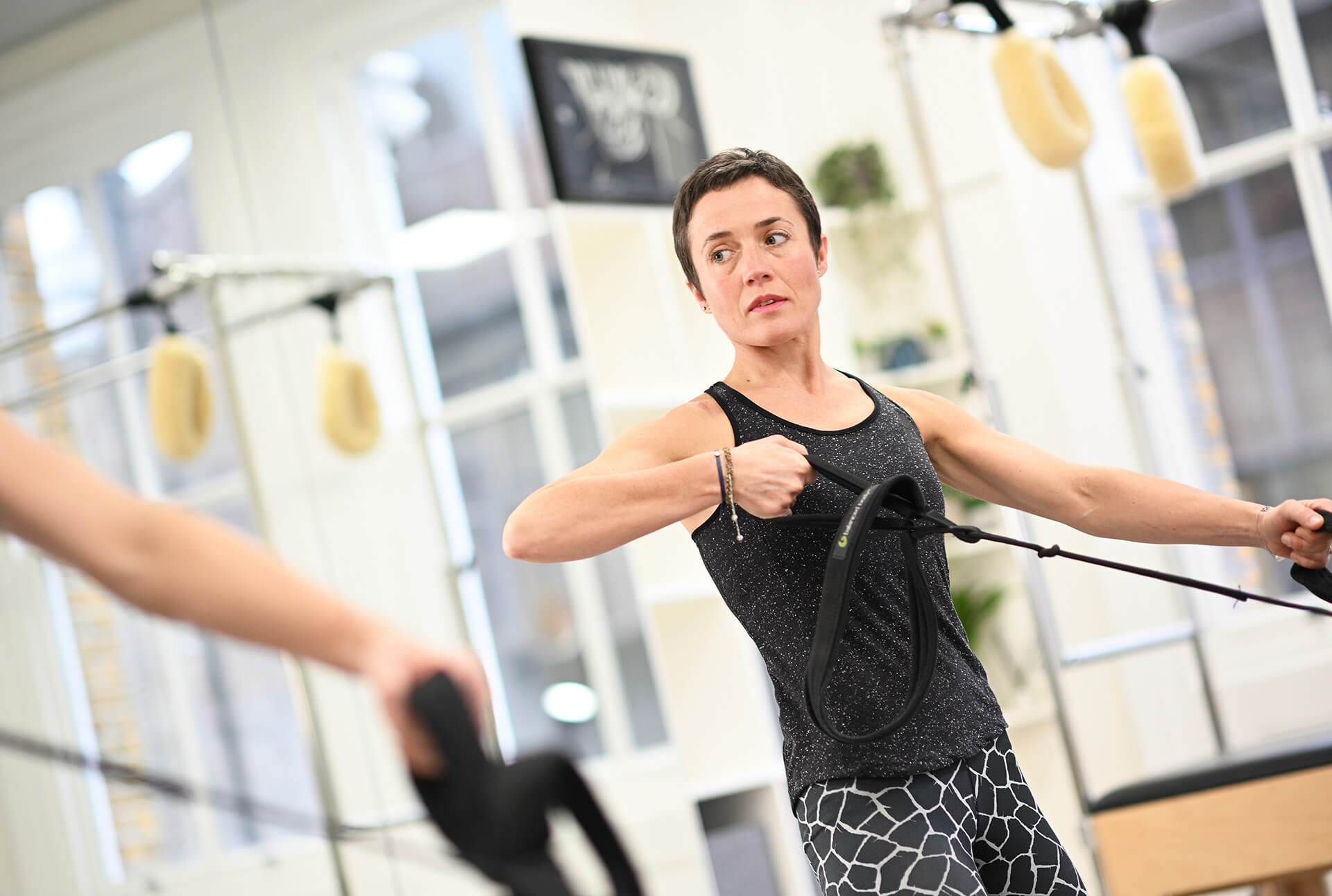Have you heard of the Pilates reformer?
You might think it sounds like a Victorian punishment but it’s actually an amazing piece of workout kit!
If you’ve ever set foot inside a Pilates studio, or seen inside a Reformer class, you might think that these leather-clad beds with all their straps and springs look a bit intimidating.
Whilst these machines might look like they belong in a torture chamber, we promise that using them does amazing things for your body.
The reformer is just one of the pieces of large equipment that you can find in a Pilates studio, alongside the barrel, pilates trapeze table and Pilates chair.
This large Pilates equipment is the most effective way of practising the Pilates method.
“You can exercise without machines” Joseph Pilates once said, “but it’s not as efficient.” That’s because Pilates equipment is uniquely designed to be able to either assist or challenge you during your workout, so it can meet everyone where they are and no people work out in the same way.
In this blog, we answer these two questions – What is reformer Pilates and why is it beneficial?
The Pilates Reformer Machine
The reformer is one of the original pieces of equipment designed by Joseph Pilates, the man who invented the Pilates method. Thanks to the growing success of reformer group classes it is also probably the most famous piece of Pilates equipment.
For those of you not familiar with the reformer, we’ve got you covered. Below you’ll find a description of the main features of a reformer. A brief introduction as to how it works and the benefits of using it.
Pilates reformer – What is it?
The reformer consists of a bed-like rectangular frame. Depending on whether the reformer is a classical studio version or a contemporary model, this frame is made from either wood or metal.
On top of the frame sits a padded platform known as the carriage. The carriage is attached to hidden runners and so is able to slide up and down the length of the frame freely.
Design elements like this makes the smooth execution of exercises possible. This helps practitioners achieve the “flow” Pilates principle.
At one end of the reformer frame is the foot bar. This is adjustable. It can be moved to change the size of the reformer to accommodate for different heights. The foot bar can also be quickly lowered or raised if an exercise requires it.
The carriage is attached to this end of the reformer with a series of springs in a range of spring tensions. These springs are only hooked on to the frame, though, and are easily removed.
By adjusting the spring tension in this way, the resistance provided by the reformer is altered. Exercises are made either easier or more difficult. Surprisingly, one light spring is often more challenging than several heavier ones.
At the opposite end of the frame are two long ropes with loop handles attached to pulleys. When it comes to the loop handles there is usually an option of a small one and a large one. The smaller ones are intended for hands and the larger ones are designed for feet.
The reformer carriage has other features such as shoulder pads (to stop you from sliding off when you’re lying down) and an adjustable headrest. All of which is designed to make your experience on the reformer more comfortable.
Pilates reformer – How does it work?
The reformer is an incredibly versatile piece of equipment and can be used lying down, standing, kneeling or on all fours.
Most exercises on the reformer involve some sort of pushing and/or pulling action. Other exercises involve keeping the carriage still whilst the tension of the springs works against you.
Another useful application of the reformer – and part of why it is so effective – is that it can be either assistive or resistive. In basic terms, this means that exercises can be made more or less challenging using the machine.
What does Reformer Pilates do?
Are you wondering what exactly the Pilates reformer can do for you? Feeling a bit intimidated by the equipment? This ingenious piece of machinery has many features which make exercise varied, interesting and fun.
The Pilates reformer can be assistive
Take an exercise like the “roll down”, for instance. The “roll down” involves the fluid movement of the spine from a “neutral” position in seated through to a rounded one. It is an exercise that mobilises the spine and strengthens the abdominals.
You can do this exercise on the mat without any equipment. But it is a pretty difficult one to do without over-recruiting muscles or using the wrong ones to help you cheat your way through it. On a reformer, however, you have the choice to hold on to the straps and add extra springs for support. This makes the exercise easier to execute.
So, rather than challenging your movement, the reformer in this instance is actually helping you perform the movement correctly. In doing so, you are forced to activate the right muscles – the muscles intended to work in “roll down”.
- The Pilates reformer is supportive. The position on the reformer supports the weight of your body. Your muscles are not having to hold you upright against gravity, so you can fully relax onto the bed.
- The Pilates reformer can assist you. The additional features of the Reformer can also support you – the bar and the foot straps can support the weight of the legs whilst you do exercises that challenge the abdominals. For example – if you were to lie on the floor doing double leg raises, the weight of both legs would be very challenging. Most people are not able to perform the exercise well and it becomes either ineffective or puts strain on the back. By adding support to the legs in the form of weighted cable the load is less – enabling you to perform the movement more effectively.
- The reformer provides feedback. The sensory feedback that you get from having the whole of your back resting on the reformer bed means that you are getting tactile information about the position of your spine and pelvis as well as how you are moving. Straps and handles that you can pull and bars you can hold or push also give you more tactile feedback and are more satisfying movements. They also mimic the functional movements that we do on a daily basis. In contrast, mat Pilates can leave you waving your arms and legs in the air without a clear idea of where your body is in space. Finally, when you pull the straps on a reformer with your hands or feet – it produces movement of the carriage which is a bit like rowing a boat. Many people find this action both fun and soothing and it also gives you a big movement in response to your hand movements.
The Pilates reformer is challenging
The Pilates reformer works using cables attached to pulleys and a moving carriage operating on spring resistance. By setting up the carriage with more spring resistance you can create more resistance to work against, making the exercises a strength challenge.
The reformer can also be set up so that you have less stability on the moving carriage and this can make exercises more challenging. For example – performing a plank on the reformer with more springs is easier, remove the springs and you have to control the movement of the carriage more.
reformer works differently for standing exercises such as “Scooter”. This is like a running movement where one leg is placed on the floor and the other on the reformer.
Instead of aiding the movement, the leg extension phase of the exercise is resisted by the springs of the reformer. This means that, as well as teaching the body to move in the “correct” way, the force created by the reformer springs is also building strength in the leg and glute.
Other benefits of the Pilates reformer
The reformer’s moving carriage and variable spring settings create a lot of opportunities for challenging the body.
For example, movements performed on the unstable surface of the carriage in combination with a light spring are great for strengthening the body’s deep stabilising muscles. These types of exercises also promote better balance and coordination.
The Pilates reformer is fun! There are endless creative ways that this piece of equipment can be used to vary exercise. You only need to look on YouTube or Instagram to see many examples of this.
The Pilates reformer can be integrated into other types of exercise – there are many ways that the reformer can be used to enhance strength training, cardio workouts
Other important features of the reformer, such as the straps and pulleys, are designed to help improve mobility, flexibility and range of motion, and they are particularly effective at doing so.
Elements like the adjustable spring tension also mean that Pilates on the reformer can be made to work for everyone. This includes beginners, pregnant women and people with injuries.
The reformer’s official name is the “universal reformer” – and clearly with good reason. Pilates on the reformer can be adapted to work for everyone. It meets every need.
Time to try the Pilates reformer
So, you’ve had the low-down on what the Pilates reformer is and how it works. Hopefully this piece of apparatus doesn’t seem quite so terrifying anymore!
If you’ve been avoiding Pilates classes because of the look of the machines, we’re hoping you now can sign up for that reformer or equipment class with confidence. Come and try reformer Pilates in Angel, or one of our other locations.
For those reformer class regulars, we believe you’ll have got something from this too. Because knowing how the equipment works and how it interacts with you during exercises can mean better outcomes in your body. Time to get studying!
Frequently Asked Questions
Is reformer Pilates good?
- We believe that reformer Pilates is one of the best exercises that you can do! However, we are more than a little biased. This ingenious piece of equipment offers a whole body strength workout and can be adjusted to suit everybody. The sheer variety of exercises that can be done on a reformer means you can never get bored.
- In addition to the classic reformer exercises originally devised by Joseph Pilates, there is a seemingly never ending variety of creative variations that Pilates teachers the world over are dreaming up! The reformer uses spring resistance and cables to offer a challenging workout for those who consider themselves already fit.
- However, whilst it looks intimidating, the reformer can also be used as an incredibly supportive piece of equipment. This makes it suitable for those who are new to exercise, recovering from illness or injury and for the older person alike.
Can I do reformer Pilates classes?
- Yes, anyone can workout using a reformer! However, there are some things to be aware of. If you have never used a reformer it is a great idea to have some individual 1:1 sessions. This is so that you can familiarise yourself with the equipment and get some individualised tuition on the basic exercises.
- Many fitness spaces offer reformer classes, making this format of exercise accessible to many more people. However, you should be aware that the spring settings on the reformer are the same for everybody – but these settings are best when they are individualised to you. It is possible to injure yourself by working with a setting that is too heavy for you or at a fast pace. A lot of gym based reformer classes focus on heavy resistance and fast paced exercise but most of the Pilates reformer exercises are designed to be done slowly and with control.
If you have any injuries or health conditions it is a good idea to consult with a health professional to make sure that the exercise is appropriate for you. You will also benefit from doing reformer Pilates with a healthcare professional with Pilates training, such as a physiotherapist. In addition to advising on appropriate exercise, they will be able to adjust the exercises appropriately for your body and your condition. They can also work with you to set achievable goals that you can work towards.







